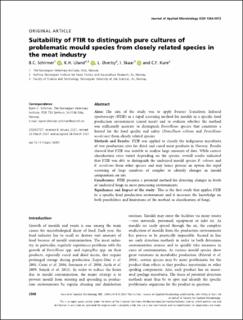| dc.contributor.author | Schirmer, Bjørn Christian | |
| dc.contributor.author | Liland, Kristian Hovde | |
| dc.contributor.author | Øverby, Lene | |
| dc.contributor.author | Skaar, Ida | |
| dc.contributor.author | Kure, Cathrine Finne | |
| dc.date.accessioned | 2022-02-01T08:41:21Z | |
| dc.date.available | 2022-02-01T08:41:21Z | |
| dc.date.created | 2021-06-29T10:53:50Z | |
| dc.date.issued | 2021 | |
| dc.identifier.citation | Journal of Applied Microbiology. 2021, 131 2308-2316. | en_US |
| dc.identifier.issn | 1364-5072 | |
| dc.identifier.uri | https://hdl.handle.net/11250/2976169 | |
| dc.description.abstract | Aims: The aim of the study was to apply Fourier Transform Infrared spectroscopy (FTIR) as a rapid screening method for moulds in a specific food production environment (cured meat) and to evaluate whether the method was sufficiently accurate to distinguish Penicillium species that constitute a hazard for the food quality and safety (Penicillium solitum and Penicillium nordicum) from closely related species. Methods and Results: FTIR was applied to classify the indigenous mycobiota of two production sites for dried and cured meat products in Norway. Results showed that FTIR was suitable to analyse large amounts of data. While correct classification rates varied depending on the species, overall results indicated that FTIR was able to distinguish the undesired mould species P. solitum and P. nordicum from other species and may hence present an option for rapid screening of large numbers of samples to identify changes in mould composition on site. Conclusions: FTIR presents a potential method for detecting changes in levels of undesired fungi in meat-processing environments. Significance and Impact of the study: This is the first study that applies FTIR to a specific food production environment and it increases the knowledge on both possibilities and limitations of the method in classification of fungi. | |
| dc.language.iso | eng | en_US |
| dc.title | Suitability of FTIR to distinguish pure cultures of problematic mould species from closely related species in the meat industry | en_US |
| dc.type | Journal article | en_US |
| dc.type | Peer reviewed | en_US |
| dc.description.version | publishedVersion | |
| dc.source.pagenumber | 2308-2316 | en_US |
| dc.source.volume | 131 | en_US |
| dc.source.journal | Journal of Applied Microbiology | en_US |
| dc.identifier.doi | 10.1111/jam.15091 | |
| dc.identifier.cristin | 1919228 | |
| dc.relation.project | Norges forskningsråd: 244627 | |
| dc.relation.project | Nofima AS: 11316 | |
| cristin.ispublished | true | |
| cristin.fulltext | original | |
| cristin.qualitycode | 1 | |
